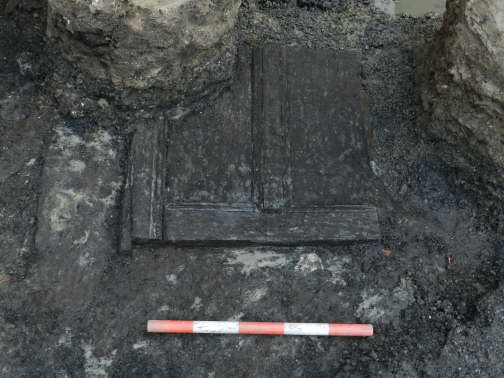The Romans loved symmetry.
That closing stile must be 3/4 of the central stile of a cut down door. I reckon whoever-it-was planed off enough to square off what's now the closing stile, to below the bottom of the panel groove, then let in the middle piece to hide the mortices where the second pair of muntins should be, but aren't. It would be neater and slightly quicker (probably) to let in one piece (into a clean mortice) than two small ones. Would you let the piece in first?
In the drawings, those haunched tenons on the closing stile have to be guesses. It might even be they're only as deep as the panel grooves run in the rails (no actual mortice at all).
This would make sense if it was originally a middle stile: the double dowels to keep it in place neatly more than to pull up the joint. They'd have been drawbored less "fiercely" than the others, because of the lack of material outboard on the tenon (so don't over-stress them).
If the drawbore dowels on the hinge side were strongly offset, it explains why there's only one per, too.
And the blindingly obvious bit (to me, anyway) is that this door is decorative. So symmetry: you'd make hinge and closing stiles as simlar as possible, and not have this odd arrangement of M+T to the 'wrong' bits.
That also helps with setting out: As it is now, it's not awkward, but it's unnecessarily fiddly (to my thinking, anyway).
To keep everything as square as possible throughout, you really want to set out the stiles together, not separately.
We also know the Romans used metal hinges on furniture, although not on human-sized doors to their houses. One account I've read says there was a pillar of harder hardwood fixed to the hinge-side stile, and pins made in the ends of that (into holes in threshold and lintel).
Is it possible that the wood where the metal hinges originally fitted is now missing, and some of the rail thickness was used to make the hinge pins when it was cheaply 'repurposed' ? If so, the door would have originally been better proportioned.
Perhaps I just saw too many Hollwood costume dramas as a child (Ben Hur, Cleopatra, etc.).
E.
PS: Andy, do you think there's some sort of overlap or loose tenon on the mitred decorative pieces? It looks as though the pins retain top and bottom which in turn retain the side pieces.

































